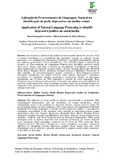| dc.relation | ARAUJO, G. D. et al. Análise de sentimentos sobre temas de saúde em mídia social.
Journal of Health Informatics, v. 4, n. 3, 2012.
BOUKIL, Samir et al. Deep learning algorithm for suicide sentiment prediction. In:
Advanced Intelligent Systems for Sustainable Development (AI2SD’2018) Vol 4:
Advanced Intelligent Systems Applied to Health. Springer International Publishing,
2019. p. 261-272.
BREIMAN, L. Random forests. Machine Learning, Kluwer Academic Publishers,
Hingham, MA, USA, v. 45, n. 1, p. 5–32, out. 2001.
CARMO NETO, Francisco Vieira do. Análise de sentimentos de reviews de produtos de
e-commerces brasileiros. 2022.
CASANI, Vinicius; et al. DP-Symptom-Identifier: Uma estratégia para classificar
sintomas de depressão utilizando um conjunto de dados textuais na língua portuguesa.
In: SIMPÓSIO BRASILEIRO DE TECNOLOGIA DA INFORMAÇÃO E DA
LINGUAGEM HUMANA. Porto Alegre: Sociedade Brasileira de Computação, (2021),
p. 153-161.
CHOUDHURY, Munmun de; COUNTS, Scott; HORVITZ, Eric. Social media as a
measurement tool of depression in populations. In: Proceedings of the 5th annual
ACM web science conference. 2013. p. 47-56.
DUPAS, Gilberto. Ética e poder na sociedade da informação: de como a autonomia
das novas tecnologias obriga a rever o mito do progresso. 2. ed. rev. e ampl. São Paulo:
UNESP, 2001.
FERNANDES, A. A. Tôrres; FILHO, D. B. Figueiredo; DA ROCHA, E. Carvalho;
NASCIMENTO, W. da Silva. Read this paper if you want to learn logistic regression.
Revista de Sociologia e Política, v. 28, n. 74, 2020.
GÉRON, Aurélien. Hands-on machine learning with Scikit-Learn, Keras, and
TensorFlow. " O'Reilly Media, Inc.", 2022.
GO, A.; BHAYANI, R.; e HUANG, L., 2009. Twitter sentiment classification using
distant supervision. CS224N Project Report, Stanford, 1(2009), p.12.
HAIDER, Mofiz Mojib et al. Automatic text summarization using gensim word2vec and
k-means clustering algorithm. In: 2020 IEEE Region 10 Symposium (TENSYMP).
IEEE, 2020. p. 283-286.
HAYKIN, S. Neural Networks: A Comprehensive Foundation. [S.l.: s.n.], 1999.
JOHANNßEN, Dirk; BIEMANN, Chris. Between the lines: Machine learning for
prediction of psychological traits-a survey. In: Machine Learning and Knowledge
Extraction: Second IFIP TC 5, TC 8/WG 8.4, 8.9, TC 12/WG 12.9 International
Cross-Domain Conference, CD-MAKE 2018, Hamburg, Germany, August 27–30,
2018, Proceedings 2. Springer International Publishing, 2018. p. 192-211.
JÚNIOR, M. A. G. N. et al. Depressão em estudantes de medicina. Rev Med Minas
Gerais, v. 25, n. 4, p. 562-567, 2015.
KONOPP, Jhonatan da Silva et al. Aplicação da Análise de Sentimento para Avaliar
Mensagens Significativas em um Ambiente Colaborativo: um estudo de caso no
ambiente Collabora. RENOTE, v. 20, n. 1, p. 132-142, 2022.
LEIVA, V.; FREIRE, A. Towards suicide prevention: Early detection of depression on
social media. In: Internet Science. Cham: Springer International Publishing, 2017. p.
428–436. ISBN 978-3-319-70284-1.
LÉVY, Pierre. O que é o virtual?. 2. ed. São Paulo: Editora 34, 2011. ISBN
978-8573260366.
LIU, B. Sentiment analysis and opinion mining. Synthesis lectures on human language
technologies, Morgan & Claypool Publishers, v. 5, n. 1, p. 1–167, 2012.
MCGIRR, Alexander; TURECKI, Gustavo. The relationship of impulsive
aggressiveness to suicidality and other depression-linked behaviors. Current
psychiatry reports, v. 9, n. 6, p. 460-466, 2007.
MELO, Ricardo Luiz da Silva. UMA ABORDAGEM PARA EXTRAÇÃO DE
RELAÇÕES ENTRE ENTIDADES NOMEADAS UTILIZANDO
AUTOENCODER E GRADIENT BOOSTING. 2022. Tese de Doutorado.
Universidade Federal do Rio de Janeiro.
MENDES, Augusto Rozendo. Detecção automática de postagens possivelmente
depressivas em redes sociais. 2021
NAEEM, Muhammad Zaid et al. Classification of movie reviews using term
frequency-inverse document frequency and optimized machine learning algorithms.
PeerJ Computer Science, v. 8, p. e914, 2022.
PIGA, Bruna Maria Fava; SHIMA, Vivian Taciany Bonassoli; ROMANICHEN, F. M.
D. F. Análise das prescrições de ansiolíticos e antidepressivos antes e durante a
pandemia da COVID-19 Analysis of prescriptions for anxiolytics and antidepressants
before and during the COVID-19 Pandemic. Brazilian Journal of Development, v. 7,
n. 11, p. 107178-107193, 2021.
QUEMEL, Gleicy Kelly China et al. Revisão integrativa da literatura sobre o aumento
no consumo de psicotrópicos em transtornos mentais como a depressão. Brazilian
Applied Science Review, v. 5, n. 3, p. 1384-1403, 2021.
SHRON, Max. Thinking with Data: How to Turn Information into Insights. "
O'Reilly Media, Inc.", 2014.
SILVA, Aldilene Clemente da et al. Uso de dispositivos eletrônicos & redes sociais
digitais: possíveis efeitos positivos e colaterais. 2021.
SIVAKUMAR, Soubraylu et al. Review on word2vec word embedding neural net. In:
2020 international conference on smart electronics and communication (ICOSEC).
IEEE, 2020. p. 282-290.
VEDANA, Kelly Graziani Giacchero. Mídias sociais e suicídio: Universidade de São
Paulo. Escola de Enfermagem de Ribeirão Preto. SMAD, Revista Eletrônica Saúde
Mental Álcool e Drogas (Edição em Português), v. 14, n. 4, p. 194-194, 2018.
VEDULA, N.; PARTHASARATHY, S. Emotional and linguistic cues of depression
from social media. In: DH. [S.l.: s.n.], 2017. | pt_BR |


